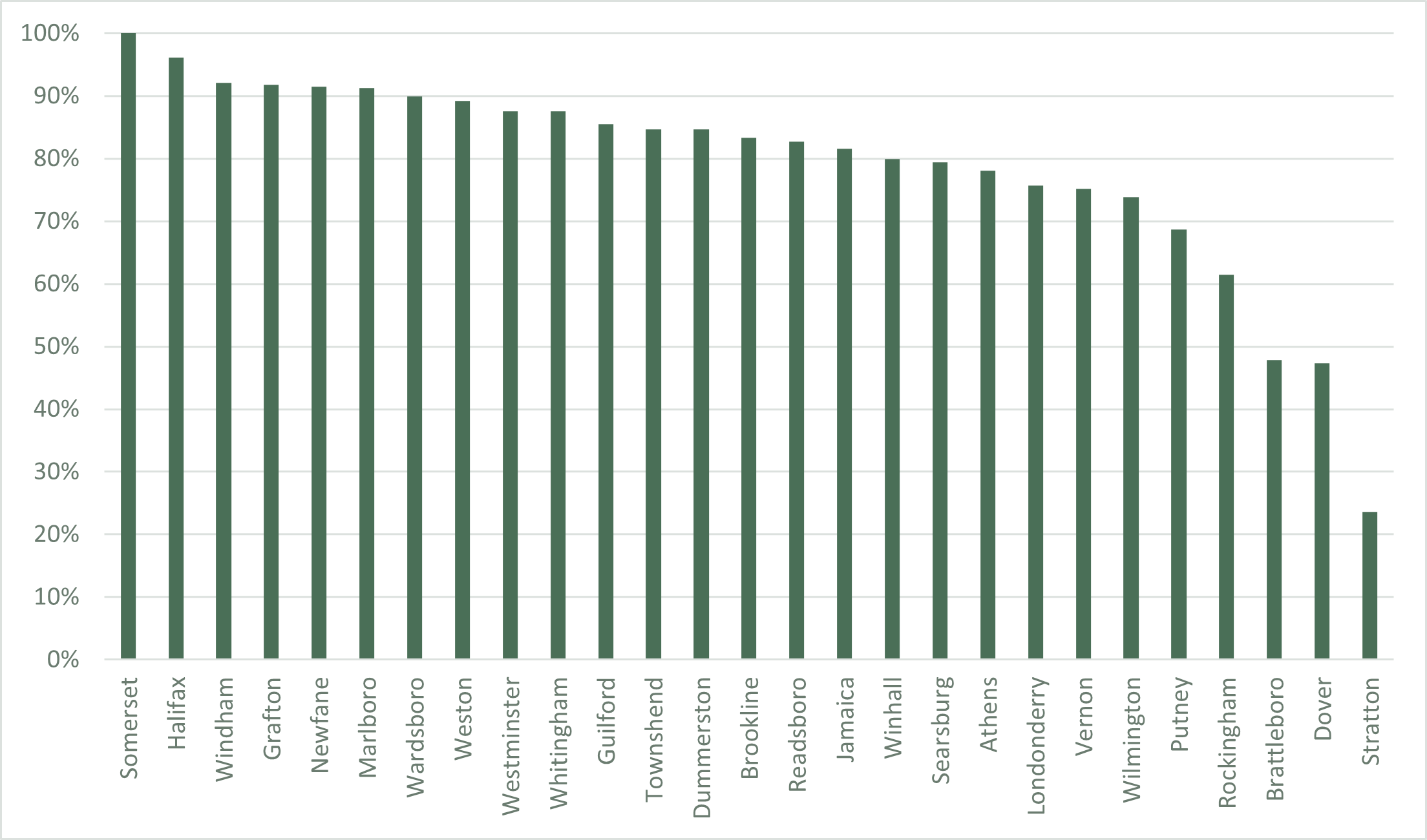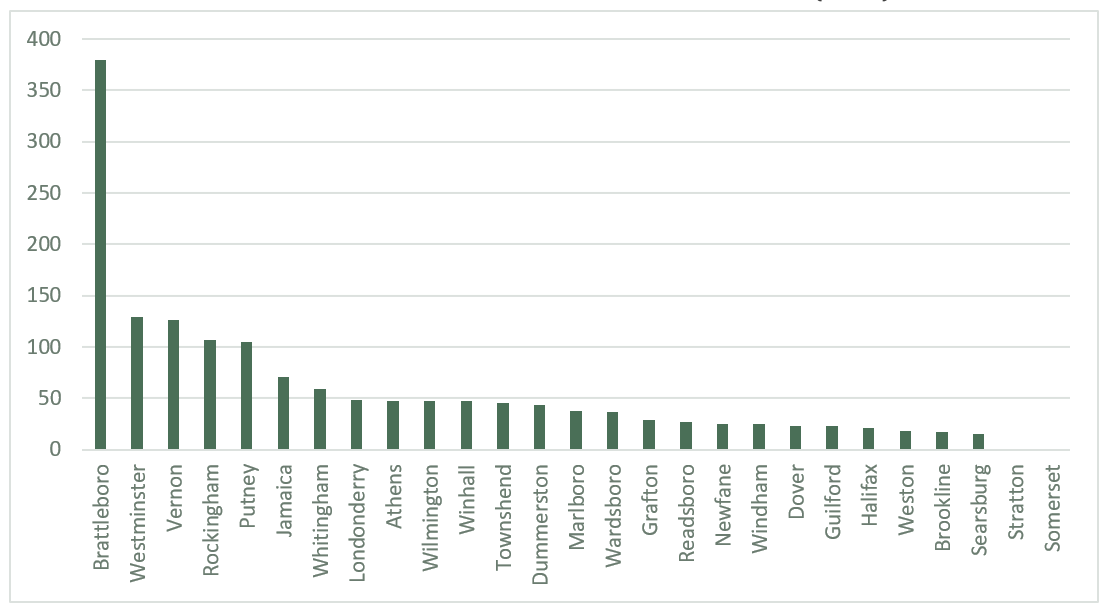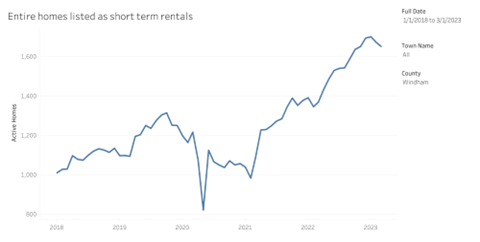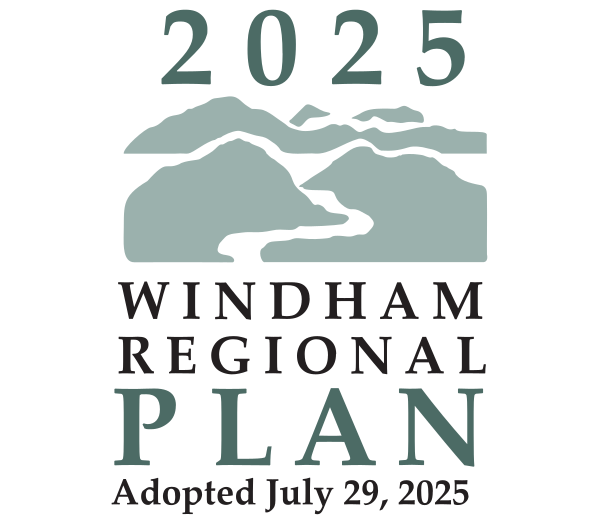Housing
Types of Housing
Single-unit Detached Homes
Single-unit detached homes continue to be the predominant form of housing in the region. Illustrating this fact, the chart below shows that the vast majority of the region’s towns have more than 70 percent of their housing units in single-unit detached homes, except for the regional centers of Brattleboro and Rockingham and the resort towns of Stratton and Dover, which have a high number of condominiums. There has not been a noticeable change in the percentage of single-unit detached homes in each town from 2010 to 2021. The lack of a variety in housing options contributes to the housing crisis because there are not enough smaller homes to meet the needs of today’s smaller households and aging population. Smaller units are often accommodated in multi-family structures.
SINGLE-UNIT DETACHED HOMES AS A PERCENT OF TOTAL HOUSING STOCK IN EACH TOWN (2021)

Multi-unit housing in the Windham Region can be found in a mix of different structure types. Some are found in two, three, and four family home in downtowns and village centers. The majority of units in large multi-unit structures (housing five or more units) are found in Brattleboro (1,464 units), Dover (418 units), Stratton (522 units) and Rockingham (249 units).
There has been very little construction of new multi-unit housing located outside of Brattleboro and Bellows Falls. New multifamily development in Brattleboro includes the DeWitt Block (19 units) developed by M&S Development, the Snow Block (23 units) developed by Windham Windsor Housing Trust, and Red Clover Commons (55 units), developed by the Brattleboro Housing Authority and designed to replace Melrose Terrace units lost to Tropical Storm Irene. In June 2023, Windham Windsor Housing Trust welcomed new residents to the Garage (27 units) in Bellow Falls. Many of these new developments have been supported with brownfields funding from the WRC.
While these new units have been a great step towards addressing housing needs in the region, the need for additional smaller units remains significant. The state’s Housing Incentive Program has provided local property owners with funding to rehabilitate or create new units in multifamily homes. Many communities have also taken steps to facilitate the development of Accessory Dwelling Units or ADUs. These units that are smaller and secondary to primary residences and may be provided in existing structures, basements or garages, or new detached structures.
Mobile homes and mobile home parks continue to be one alternative to high cost housing in the region. As can be seen in the chart below Brattleboro has a significant majority of mobile homes in the region, followed by Putney, Rockingham, Vernon and Westminster.
TOTAL NUMBER OF MOBILE HOMES PER TOWN (2021)

Mobile home parks can achieve unit densities that reduce costs, however community sewer and water, whether public or private, are essential for a park’s viability. The costs involved in building and maintaining such infrastructure make mobile home park ownership unattractive as a business investment. Additionally, these parks are often located in floodplains or other marginal parcel locations to save costs. This issue was highlighted when many mobile home parks throughout the state were damaged by flooding in Tropical Storm Irene and during the July 2023 floods. TriPark in Brattleboro recently revealed plans to move additional units out of the floodplain with significant funding provided by the state and federal governments.
SEASONAL HOUSING AND SHORT TERM RENTALS
Seasonal housing and Short-Term Rentals (STRs) impact the amount and costs of housing available to permanent year-round residents. Tourism and outdoor recreation are a critical part of the region’s economy and seasonal dwellings and STRs for visitors are part of that mix, along with traditional resort lodging and hotels and motels. Providing the right balance of housing that is affordable to year-round residents and seasonal housing and lodging options for visitors is a challenge.
In Windham County, seasonal dwellings make up 32% of all homes. Communities in the Deerfield Valley, our resort towns, have the most seasonal housing. Dover is listed as number two in the state for the total number of second homes, followed by Wilmington at #6, Stratton at #7 and Winhall at #8. In these same communities, the percentage of total homes that are seasonal is also high: Dover 80%, Wilmington 62%, Stratton 92%, and Winhall 83%. During the COVID pandemic, some seasonal homeowners relocated to Vermont and lived in their second homes. Others looking to move away from urban centers purchased homes that may or may not become permanent residences. This influx of out of state buyers is one factor contributing to an increase in housing costs in the region and is especially impacting year-round residents and employees in resort communities.
STRs in their current form are a relatively new phenomenon, although there have always been vacation rentals in resort communities. Airbnb and other STR platforms have now made marketing these units much easier for homeowners. This trend began several years ago, but increased significantly since the COVID pandemic, as can be seen below. This trend has also impacted the amount and cost of housing available to permanent residents.
NUMBER OF ENTIRE HOMES LISTED AS SHORT-TERM RENTALS
WINDHAM COUNTY (2018-2023)

People make homes available as STRs for many different reasons. For some it is strictly a business, but others may use it as a way to afford their housing or as a way to stay in the region. There are multiple ways that communities can begin to address this issue if it is a concern, including registering STR owners/operators, regulating the number of STR units, or requiring fees to address impacts. Communities must balance their ability to provide accommodations for visitors with the need for also ensuring affordable housing to year-round residents.
